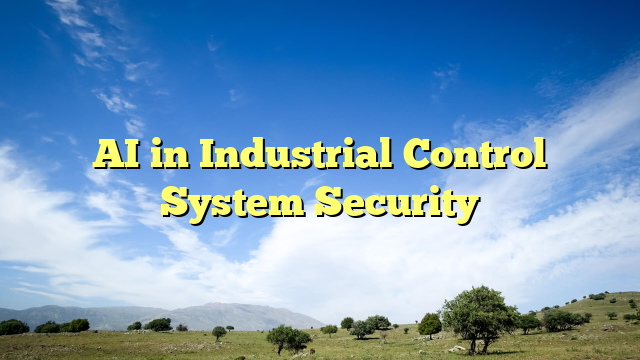AI in Industrial Control System Security
Introduction
Imagine this: A major power plant suddenly shuts down, plunging an entire city into darkness. The cause? A cyberattack on its industrial control systems (ICS). This isn’t science fiction—it’s a real-world threat that’s growing every day.
Industrial control systems are the backbone of critical infrastructure, from energy grids to water treatment plants. But as these systems become more connected through industrial IoT, they’re also becoming more vulnerable to cyber threats.
Enter AI infrastructure protection. By leveraging machine learning and advanced analytics, AI is transforming how we secure ICS. In this post, we’ll explore how AI is safeguarding critical systems, the challenges it addresses, and actionable steps to implement these technologies. Let’s dive in!
Protecting Critical Infrastructure with Machine Learning Anomaly Detection
Why ICS Security Matters
Industrial control systems are the unsung heroes of modern infrastructure. They manage everything from electricity distribution to manufacturing processes. But as these systems integrate with industrial IoT, they’re exposed to new risks.
Traditional security measures often fall short because they can’t keep up with the complexity and scale of modern threats. That’s where AI infrastructure protection comes in.
How AI Enhances ICS Security
AI brings a new level of intelligence to cybersecurity. Here’s how:
1. Real-Time Threat Detection: AI algorithms analyze vast amounts of data in real time, identifying anomalies that could indicate a cyberattack.
2. Predictive Analytics: machine learning models predict potential vulnerabilities before they’re exploited.
3. Automated Response: AI can automatically isolate compromised systems, minimizing damage.
For example, a leading energy company used AI to detect a sophisticated malware attack on its ICS. The system flagged unusual network traffic patterns, allowing the team to neutralize the threat before it caused a shutdown.
Step-by-Step Guide to Implementing AI in ICS Security
Step 1: Assess Your Current Security Posture
Before implementing AI, you need to understand your current vulnerabilities. Conduct a thorough audit of your ICS and industrial IoT systems.
– Identify critical assets and their dependencies.
– Map out potential attack vectors.
– Evaluate existing security measures.
Step 2: Choose the Right AI Tools
Not all AI solutions are created equal. Look for tools specifically designed for ICS security. Key features to consider:
– Anomaly Detection: Can the tool identify unusual patterns in network traffic or system behavior?
– scalability: Will it work across your entire infrastructure?
– Integration: Does it integrate with your existing security systems?
Step 3: Train Your Team
AI is only as good as the people using it. Invest in training for your cybersecurity team.
– Teach them how to interpret AI-generated alerts.
– Provide hands-on experience with the tools.
– Encourage collaboration between IT and operational teams.
Step 4: Monitor and Optimize
AI systems need continuous monitoring and fine-tuning.
– Regularly review AI-generated reports.
– Update machine learning models with new data.
– Stay informed about emerging threats and technologies.
Real-World Examples of AI in Action
Case Study 1: Securing a Smart Grid
A utility company implemented AI-powered ICS security to protect its smart grid. The system detected a ransomware attack targeting its control systems. Thanks to AI’s rapid response, the attack was neutralized before it could disrupt power distribution.
Case Study 2: Protecting a Manufacturing Plant
A global manufacturer used AI to monitor its industrial IoT devices. The system identified a compromised device that was sending sensitive data to an external server. The device was isolated, and the breach was contained.
Challenges and Considerations
While AI offers immense potential, it’s not without challenges.
1. data privacy: AI systems require access to sensitive data, raising privacy concerns.
2. False Positives: Over-reliance on AI can lead to unnecessary alerts, overwhelming security teams.
3. Cost: Implementing AI can be expensive, especially for smaller organizations.
To overcome these challenges, start small. Focus on high-priority areas and scale up as you gain experience.
Conclusion
The stakes have never been higher for ICS security. As cyber threats grow more sophisticated, traditional security measures are no longer enough. AI offers a powerful solution, enabling real-time threat detection, predictive analytics, and automated responses.
By following the steps outlined in this post, you can start leveraging AI infrastructure protection to safeguard your critical systems. Remember, the goal isn’t just to react to threats—it’s to stay one step ahead.
At TheBizWizAcademy.com, we’re committed to helping entrepreneurs like you navigate the complexities of modern technology. Whether you’re securing an industrial control system or building an online business, our step-by-step training and supportive community are here to guide you.
Ready to take your cybersecurity strategy to the next level? Join us today and start building a safer, smarter future.
SEO Title: AI for Industrial Cybersecurity: Safeguarding Critical Systems
SEO Description: machine learning applications in industrial control system protection.
Backlink: /ai-industrial-security
External Links:
1.
2.
By following these strategies, you’ll not only protect your critical infrastructure but also gain a competitive edge in today’s digital landscape. Let’s make it happen!
🚀 Want to level up your online business? Join TheBizWizAcademy and start Networking and Learning!
